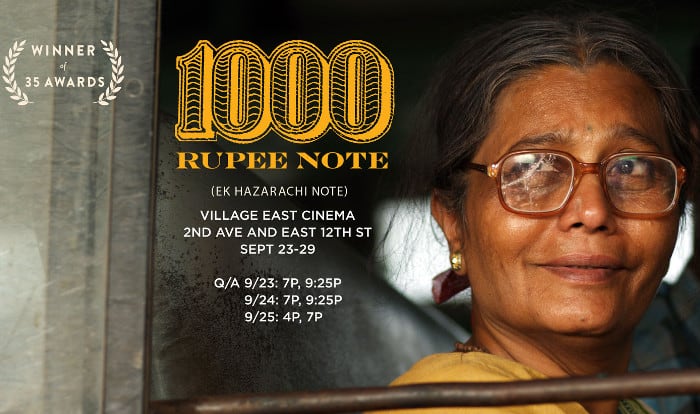
By clicking “Accept All Cookies”, you agree to the storing of cookies on your device to enhance site navigation, analyze site usage, and assist in our marketing efforts Cookies Policy.

[Photo Credit: Facebook/1000RupeeNote]
The critically acclaimed Marathi language film “Ek Hazarachi Note” (1000 Rupee Note), produced and directed by independent filmmaker Shrihari Sathe, got its U.S. theatrical release on September 23.
The film is set against the backdrop of farmer suicide in Phoolumbri village in eastern Maharashtra and follows Parvati, fondly called Buddhi, and the extraordinary circumstances she finds herself in. Essayed by veteran Marathi actress Usha Naik, Buddhi is a frail old woman who lives in abject poverty after losing her husband and her son to debt-related suicide. Despite her loss, she leads a very content life with a set routine. She wakes up in the morning, spends a few rupees on her daily breakfast of tea laced with jaggery and bun bread, goes to the temple, earns her living as a housemaid and spends time with her beloved neighbor Sudama, who she treats like her own son.
Her mundane village life is upended when a power-hungry politician, convincingly played by Ganesh Yadav, visits her village seeking support for his re-election. Buddhi attends the election rally in the hope of getting free food but ends up getting a few thousand rupees. Thanks to the munificent politician, from scratching a living she is now holding few thousand rupee notes. But for people like Buddhi, money comes with its own set of problems.
The film explores the quandary in which Buddhi and Sudama find themselves when she decides to go shopping with the money she received.
“Ek Hazarachi Note,” written by Shrikant Bojewar, a resident editor of Maharashtra Times, is a scathing satire on powerful people’s apathy towards the poor. The film highlights the gaping divide between the haves and the have-nots—as well as how the latter lacks any control over their lives simply because they are poor. With an unflinching accurate eye, Sathe exposes the power-wielding local cops and portrays them as insensitive and opportunistic when it comes to treating poor people.
The songs, written by Bojewar and composed by national award winning composer Shailendra Barve, carry a certain melancholy that goes well with the film’s theme. The opening song, “Dhondi Dhonidi Pani De,” subtly highlights the worries of the rural agrarian class over the extended dry spell. The soft track and the cinematography beautifully portray the village life but it is the brilliant cast that gives the film its authentic edge. With their effortless and simplistic acting, the lead characters—Naik and Sandeep Pathak—will surely tug at your heartstrings.
For his directorial debut, Sathe brilliantly delivers a simplistic yet thought-provoking film about a sad reality. Armed with a tight script, he successfully explores the themes of farmer suicide, poverty, illiteracy and corruption in less than 90 minutes. It’s certainly a rare story made with a bittersweet voice.
It’s no wonder, then, that the film has been festival-goers favorite since it was first released two years ago. Since 2014, the film has been screened at various Indian and international film festivals and has received over 30 awards, including special jury award and the centenary award for best film at the International Film Festival of India.
Sathe explained the late release in of the film in U.S. by saying that “releasing independent arthouse films from South Asia in the international market is tough.” He, however, partnered with Kino Lorber/Silk Road Cinema, a theatrical distribution label dedicated to releasing award-winning arthouse films from South Asian countries.
Although the movie is in Marathi, Sathe insists that it is not a Marathi film. He talked about how the film could still be relevant in any other language and that “in cinema, the spoken language (itself) is secondary to the visual and emotional language of the film.”
“This film could have easily been in Hindi, Tamil, Kannada or, in this case, Marathi. That’s why ‘1000 Rupee Note’ (Ek Hazarachi Note) is not a Marathi film but a film in the Marathi language,” he said. “I’ve always believed that in cinema, spoken language is secondary, and the visual and emotional language of a film is of primary importance. This is something that transcends boundaries (language, cultural and emotional boundaries).”
When asked what he wants his audience to take away from the film, he said, “Every person reacts to a film in different ways, so I don’t want to cloud someone’s experience. I would love for the audience to immerse themselves into the world we’ve created, just go with it and have their own experience.”
The film is currently playing in New York’s Village East Cinema.
For breaking news and live news updates, like us on Facebook or follow us on Twitter and Instagram. Read more on Latest India News on India.com.